It’s hard to believe that another few months have passed and it’s time for another installment of the greatest assembly of comic book blogging talent on the internet – the Super Blog Team-Up! In this volume, we super bloggers are teaming up to write about team-ups, whether they be wacky, obscure, or just plain fun. Since I’ve been surfing the Spider-Verse the past few weeks in anticipation of the next big Spider-Man event, “Spider-Verse,” I thought I would write a post about this deep cut of an issue from 1995, Spider-Man 2099 Meets Spider-Man, by Peter David with art by Rick Leonardi and Al Williamson. Not only does this issue mark the very first pairing of the modern day Spider-Man, Peter Parker, with his futuristic counterpart, Miguel O’Hara, but it also is the debut for another alternative Spider-Man, Spider-Man 2211 (Jamoff Borne, from Earth-9500).
So let’s start this team-up on team-ups. Super Bloggers assemble!
Not since the mid-1970s when Superman met Spider-Man for the first time was there such a penchant for the “Big Two” to develop some of the most outrageous couplings they can think of, as there was in the mid-1990s. We had Batman and Spawn teaming-up, the Punisher terrorizing Archie and Riverdale, and even a huge inter-company event, DC vs. Marvel (or Marvel vs. DC, depending on which side of the fence you’re on). As such, it was inevitable that Spider-Man and the ultra-popular Spider-Man 2099 were going to get together at some point, despite the fact that they were from different timestreams (it’s not like that ever stopped DC before).
Of course, part of what makes Spider-Man 2099 Meets Spider-Man such a unique entry in the “wild and crazy mid-90s team-up” category is the wit and snark of the man who wrote it, Peter David. David, of course, created Miguel O’Hara a few years prior, turning Spider-Man 2099 into a consistent seller, even up until its somewhat politically charged cancellation after 46 issues (David resigned after issue #44).
Spider-Man 2099 was never a conventional book, and Miguel was never a conventional Spider-Man, despite the character’s affinity for his predecessor, Peter. As such, anything with David at the helm wasn’t going to be just another recycled team-up, and the book shines as a result of the middle-finger David’s script subtly sticks in the air to industry conventions. At one point, when Peter and Miguel finally end up in the same timestream, Peter jokes that “this is the part of the story where we’re supposed to fight,” but rather than waste everybody’s time with another hackneyed plot device, the two put aside their nonexistent differences and work together to save the “Marvel Age” of heroes.
On the flipside of that argument, it’s hard to gauge exactly how seriously the reader should be taking this story. Spider-Man 2099 Meets Spider-Man certainly “counts” in terms of that sometimes all-too-important continuity – the story is referenced by Miguel after he enters the modern day timeline in Superior Spider-Man last year. But there are a number of plotpoints that David seemingly shrugs off rather than explain. Peter and Miguel just sorta poof into each other’s timelines when the comic starts, and it’s later explained away as being part some of timestream experiments being conducted by Fujikawa in the present and Alchemax in 2099. It’s definitely a bit of a deus ex machine, but the story succeeds precisely because it doesn’t get bogged down in trying to define exactly what is happening. All that ultimately matters is that Peter is in 2099, Miguel woke up in bed next to Mary Jane in the modern day (lucky him!) and just … go with it.
I realize there are plenty of comic book readers out there who obsesses over these tiny details in an effort to play “gotcha” with creators, but I think there’s a lesson to be learned with this one particular story: sometimes “just go with it” is as good of a reason as a complicated, Final Crisis-esque explanation of what’s going on in the universe. I say that, because once you look past some of the convoluted issues of the story itself, you’re left with a very solid character-driven piece, that’s also a lot of fun. Rather than using the time-switch to create a conflict between Peter and Miguel that focuses on the issues that divide them, David crafts a story that provides the characters with a better understanding of each other. And if you’re going to do a one-off event that will likely never happen again (or at least not until nearly 20 years later, as was the case here), I would much rather read a story that promotes the very best and/or memorable elements of character than something that gets bogged down in minutiae.
To provide a bit more context in what I’m referring to with all this rambling, there’s an absolutely fantastic line from Miguel in the first half of this story as he’s swinging across the modern day New York City. Observing at how the city is without the efficiency and safety of his future world, while also lacking the draconian measures that enforce this efficiency and safety, Miguel says, “It looks and smells like Hel! And it feels like paradise.”
Meanwhile, Peter is not quite as conflicted in the future, though he does find the breed of bad guys he needs to take down (in this case, the 2099 version of the Vulture who leads a gang of cannibals), is not up to his usual present-day standards (considering by the mid-90s Peter spent the bulk of his time fighting Jackal and evil clones of himself, that’s not saying much). However, he too notices that despite the fact that guys like J. Jonah Jameson make him out to be a crook in the present day, his original world is still a more desirable place than Miguel’s dystopian future.
In order to give Miguel something else to do in the book, we get a showdown between him and Venom, which offers David another opportunity to take a subtle jabs at what was being touted by Marvel as the gold standard for superhero storytelling during the era. By this point in time, Venom’s popularity was on the decline, as they character became overexposed and repetitive. So, naturally, as Venom decides to beat up on Miguel for the fun of it, O’Hara makes a comment about the villain’s myopic nature – “there’s something happening that’s bigger than you or me,” referring to the fact that the “Heroic Age” of Marvel is about to get blipped out of existence unless Miguel can give his undivided attention to saving the day. Maybe I’m over-reading the script, but the line really does come across as a smackdown of the Venom status quo and how Marvel would force him down reader’s throats for seemingly every major event starring Spider-Man (at least this book lacked Carnage).
Like the book’s initial premise, the random appearance of Spider-Man and Hobgoblins from 2211 is another “just go with it” moment courtesy of David and the art team. Perhaps David at some point envisioned doing some kind of mega Spider-Man event that involved a bunch of different Spideys from various timestreams (sound familiar?), but the only purpose the 2211 cast serves in this story is to provide some semblance of explanation of what exactly is going on – which is that the destruction of the “Heroic Age” was all part of a plot that was hatched by the futuristic Hobgoblin (who we later learn is the daughter of Spider-Man 2211). For those keeping score at home, the 2211-verse makes a second appearance about a decade later in the David-scripted Friendly Neighborhood Spider-Man.
Still, the book is at its best when the two main Spideys interact with each other. Before each returns to their original timestreams, Peter and Miguel share a really wonderful moment where they ask each other why they are Spider-Man. Both respond “because I have to,” which might sound glib, but is actually a very efficient way of summing up, “with great power, there must also come great responsibility.” Then, Miguel throws in there “because of you,” referring to how Peter/Spider-Man is revered as a hero in the future, and how following in his footsteps is an honor for Miguel – a nice little sentiment that makes both characters look great.
With the expectation being that both Peter and Miguel will play key roles in “Spider-Verse,” I do hope that the characterization scripted by David in this one-shot is maintained and maybe even built upon for this new event. I expect that with David still in the fold and scripting the current 2099 series, that there will be some effort to maintain what was initially put forward in Spider-Man 2099 Meets Spider-Man. Because at the end of the day, good characters and fun superheroics is what keeps me coming back to comics, not clunky explanations of theoretical science.
Don’t forget to check out these other great Super Blog Team-Up sites:
Super-Hero Satellite: Super Man and The Masters Of the Universe
LongBox GraveYard: Thing /Thing
Superior Spider-talk: Spider-Man and the Coming of Razorback?!
The Daily Rios: New Teen Titans/DNAgents
The Middle Spaces: Daredevil/Spider-man/Sin Eater
Vic Sage/Retroist: Doctor Doom/Doctor Strange
Fantastiverse: Superman/Spider-Man
Mystery V-Log: The Avengers #1
In My Not So Humble Opinion: Conan /Solomon Kane
The Unspoken Decade: Punisher/Archie!!
Flodos Page: Kyle Rayner and ???
Between The Pages: World’s Finest Couple: Lois Lane and Bruce Wayne
BronzeAge Babies: FF/Doom, Batman/Joker, Warlock/Thanos, and Cap/Red Skull

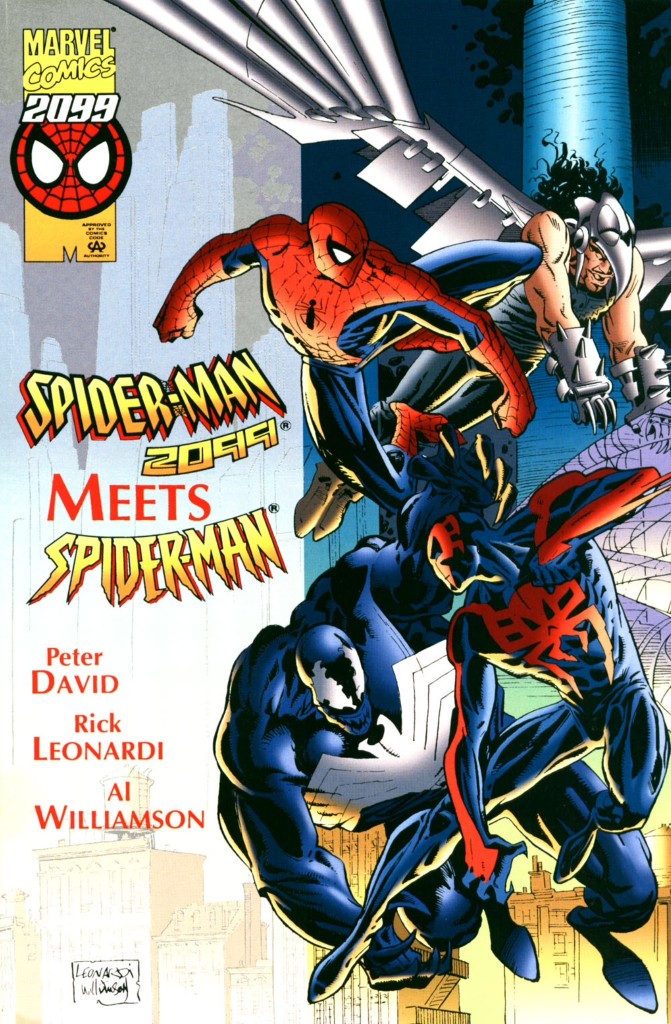
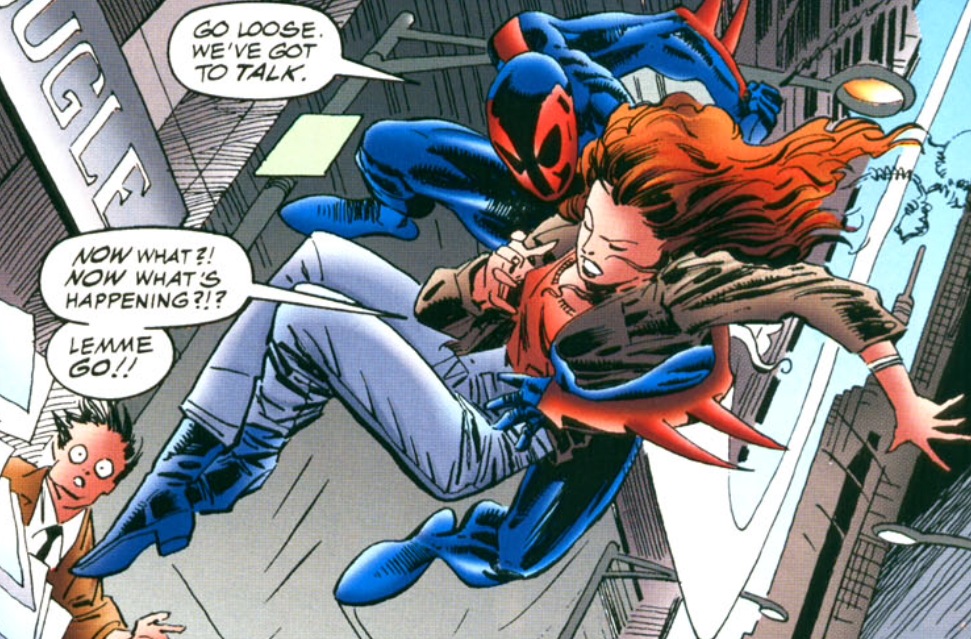
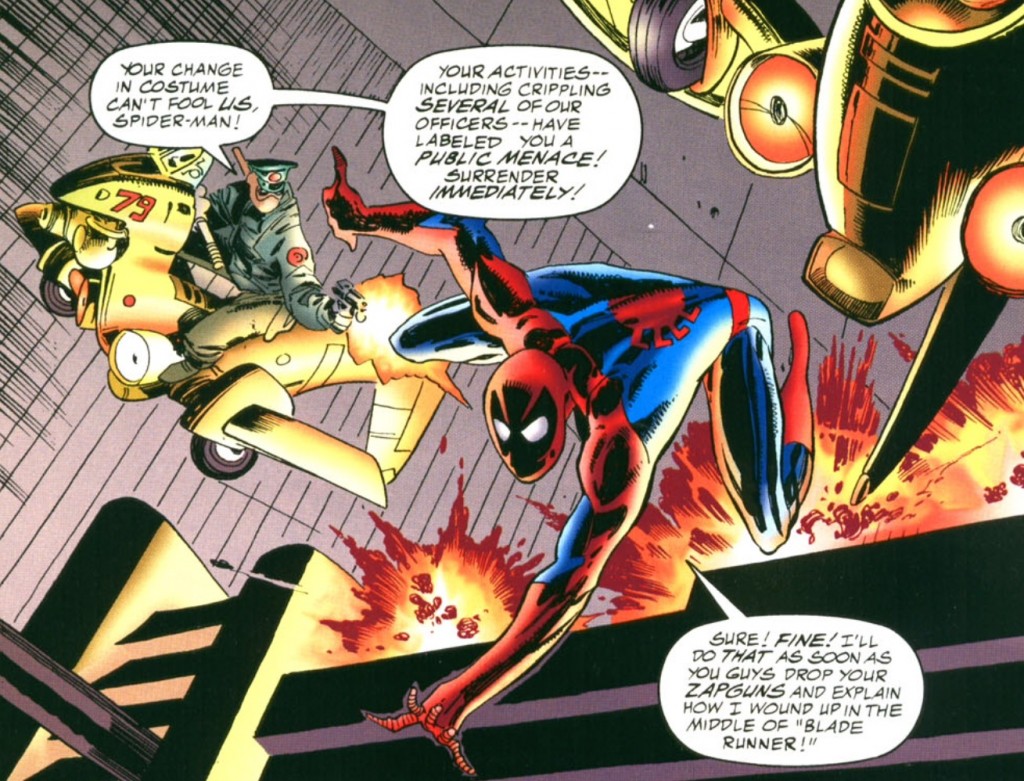
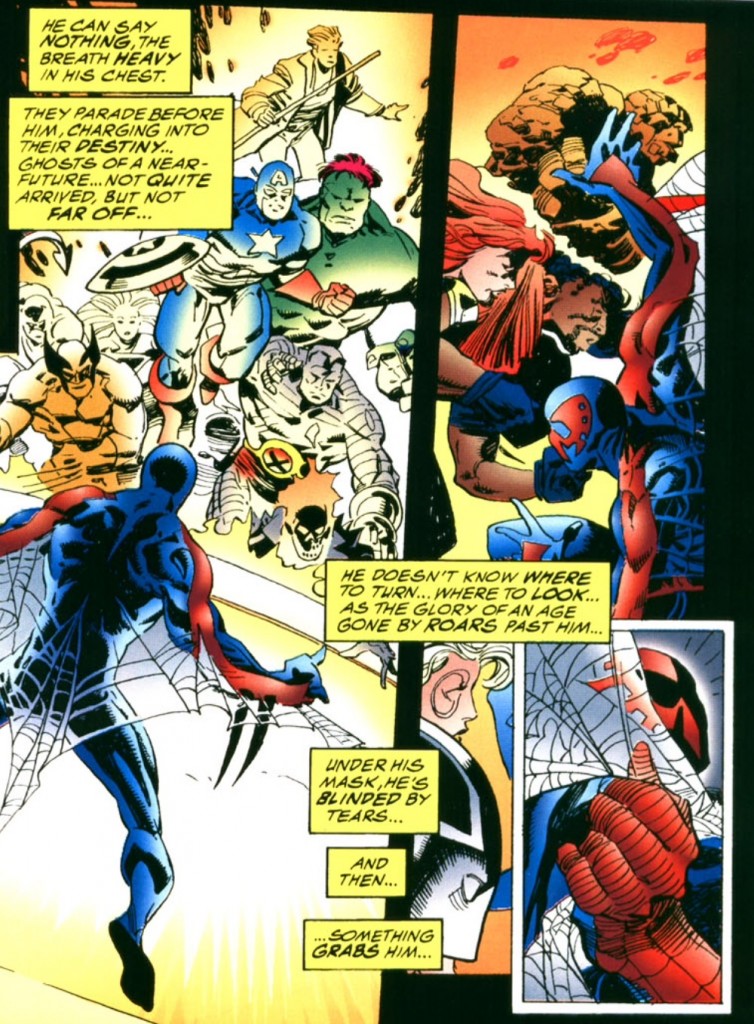
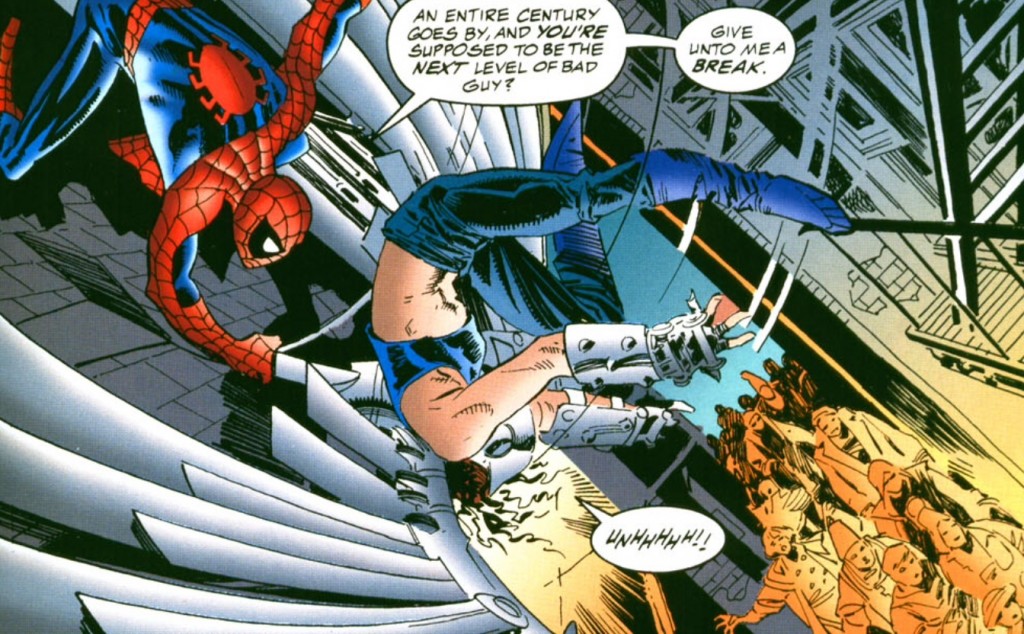
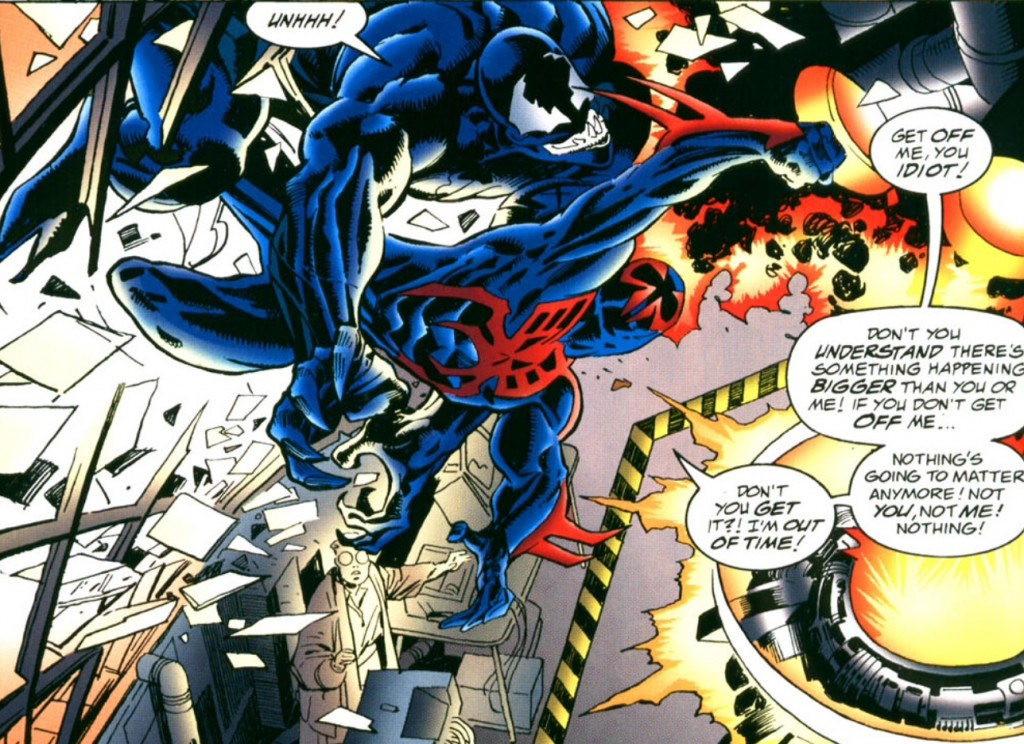
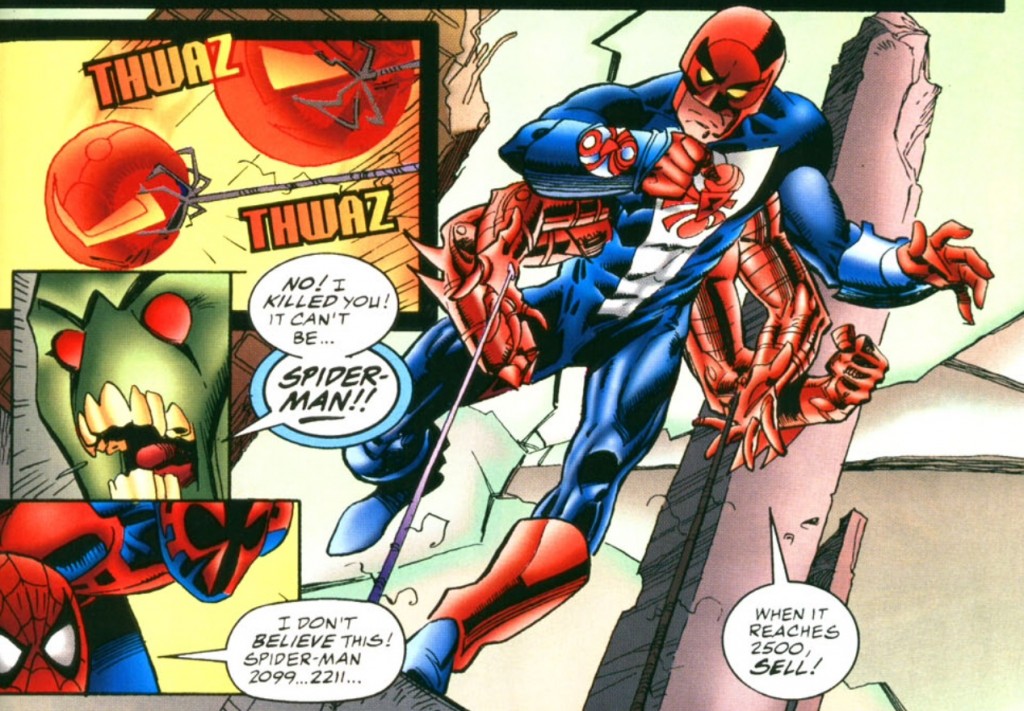
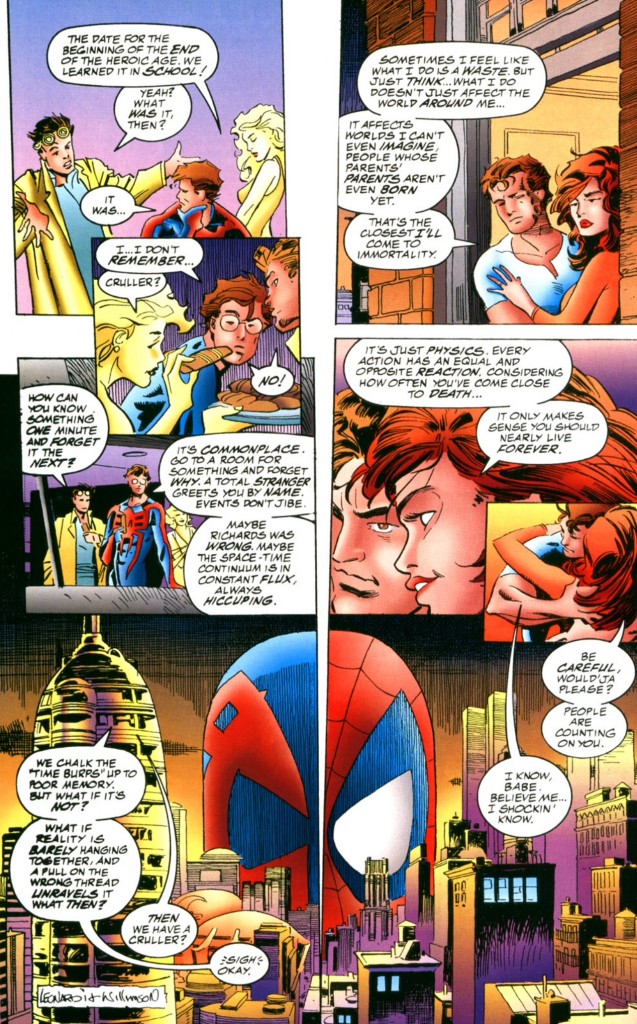

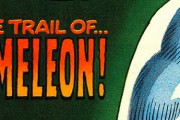
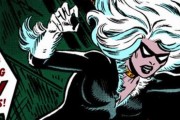
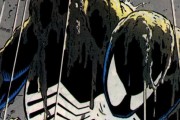
Spiderman 2099 is Amazing..pardon the pun!! Wish he could hang a while longer in our time line!! Makes me want to go grab my stack of 2099s and dig in!!
Wish it was drawn better….
Always curious to read these summaries of 1990s comics — I missed that whole decade, and sometimes I feel like Steve Rogers filling in the blanks (and I feel like Cap even more so when a 90s book makes me pine for the past).
Sounds like this team-up was better than it had any right to be — the author was wise to concentrate on the emotional landscape of the characters. There’s rarely any tension in how these “fight books” will turn out (and that counts double for team-ups and cross-overs), but the smaller, character stakes can keep us guessing right up until the end. Years later, it is the characters that we remember — the action, not so much.
I really appreciated Spiderman 2099. For one thing Miguel was the only Latino/hispanic hero out there of note. Moreover, David’s take on the future was always thoughtful and captivating. I missed this team up, but I’ll be on the look out for it. May I ask, do you know: why did Peter David resign and why was the cancellation of the book politically charged?
Thanks for reading and commenting. From my understanding, there was a ton of Marvel editorial interference during the final days of 2099… keep in mind the mid-90s was a really rough time for the industry because the sales balloon bubble burst and even though 2099 was netting like 100K sales (which would make it a chart-topper today), Marvel was desperate to get back to the “good old days” when the top books would top a 500K-1 million readers. So they started to run more and more crossovers to sell the other 2099 books and then they started to dictate certain character reveals and Peter just had enough and quit because he was very proud of that book and didn’t appreciate the lack of say he had in its direction.
He quit X-Factor over similar reasons, if memory serves.
Out of all the 2099 titles, Spidey’s was the best, although Doom & the insane Punisher title deserve honorable mention. Other than Ravage, though, the entire line was likable, though, and it was fun for me as a teen b/c it was something familiar to me, but new. This crossover, as you made clear, was better than it had any right to be, although the same might be said of Spider-Man 2099 in general.
Great job telling the story w/o ruining the comic book, by the by. There’s still lots in the comic book to enjoy even after reading this.
Thanks for a great article and all the hard work!